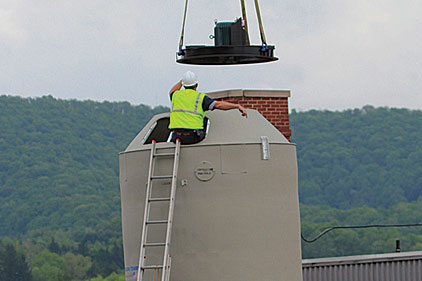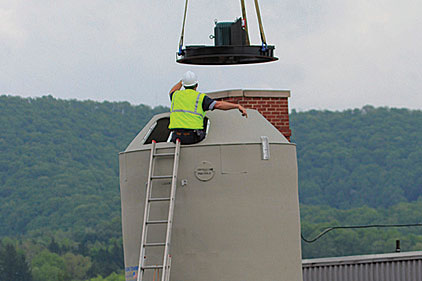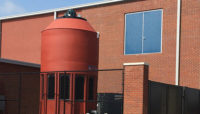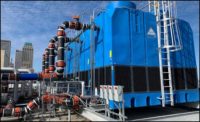
|
| Davis Memorial Hospital in Elkins, WV, chose these plastic cooling towers in an effort to not only solve performance problems but also to protect against corrosion issues. |
It’s no secret that hospitals contain some of the most diverse and demanding environments that require dependable performance of the HVAC system. Operating rooms, critical care facilities, data centers and imaging centers all are to some extent dependent on the reliable operation of the HVAC system, particularly in warm weather.
When cooling towers are sluggish or out of service for maintenance, added stress is placed on chillers, and in turn the performance of the HVAC system is often downgraded.
This was the case with Davis Memorial Hospital in Elkins, WV. A subsidiary of Davis Health System, the 160,000-sq-ft-hospital was founded in 1904, fully renovated in 1994, and is now undergoing an expansion of 72,000 sq ft.
To overcome recurring cooling tower-related HVAC performance problems, Davis Memorial purchased two new cooling towers to support its two 300-ton Carrier chillers.
“I researched various cooling tower technologies on the internet and found a unique line of cooling towers that feature a seamless plastic shell,” said Steven Johnson, director of Davis Memorial Support Services. “The one that attracted my attention was a line that was made of high-density polyethylene (HDPE) manufactured by Delta Cooling Towers. Of course, there were a lot of other models available, but most of them seemed to be the metal-clad design.”
Johnson found the HDPE cooling tower shells appealing since they are virtually impermeable to corrosive elements, including water treatment chemicals such as chlorine, as well as to UV rays.
Johnson and engineers from Davis Memorial, along with some from Carrier, decided to visit Delta Cooling Tower manufacturing for a plant tour so that they could get a closer look at the design and building of the manufacturer’s product line.
“We were all impressed with the plant tour,” Johnson says. “Not only was management helpful in explaining the features and benefits of various product models, but they also helped us confirm our preliminary specs for the cooling towers we had in mind. We were quite surprised to learn that this line of cooling towers was about 20% less expensive than many conventional designs.”
The two towers selected by the Davis Memorial team included a 250-ton TM Series unit and a 180-ton Paragon Series tower.
Added features
While the avoidance of downtime and the need for unscheduled cooling tower maintenance were critical requirements for Davis Memorial Hospital, there were other features of the Delta design that also had significant value.
“The variable-speed, direct-drive motors that run the fans on our new towers also provide unexpected benefits,” Johnson said. “First of all, these drives are far more efficient than we initially realized. The fan motors on our old towers were 30 hp each, and consumed considerably more energy than the new ones, which are only seven hp each, and at least 50% more energy efficient.”
Johnson explains that the hospital’s old fan motors were either on or off. With the new variable-speed drives, they are set up so that it has to be a hot day before they run at 100%.
“The new direct-drive fans are usually running at about 40%,” he said. “Running at 100% they are only pulling four amps, which is much less energy than before.”
Johnson adds that the new direct drives are also far less maintenance-intensive, which results in even greater savings. With no belts, shafts, bearings or other external parts to service, the direct-drive motors are virtually maintenance free.
Another important benefit of the new direct drive cooling towers is that they run quiet.
“Drives using belts often require adjustments, or you will hear them squeal,” Johnson explains. “We’re a hospital, so quiet is expected. Also, we’re located right in the middle of a residential community. In the past, we received complaints from people in the neighborhood if the belts were squealing, particularly if it happened at night when they were trying to sleep. That was a serious problem, so our maintenance people often had to fix the belts in the middle of the night. With the direct drive fan motors, we don’t have that problem.”
Johnson summarizes that his new cooling towers have not only solved his chiller and HVAC problems, but have exceeded expectations.
“These new cooling towers have virtually eliminated unscheduled emergency maintenance,” he says. “That not only makes us happy, our chiller maintenance contractor is also very pleased.”
The hospital estimates that with the combined savings on energy, water usage, maintenance, and chemicals that the hospital is now realizing, payback for the new cooling towers should be within two years.



